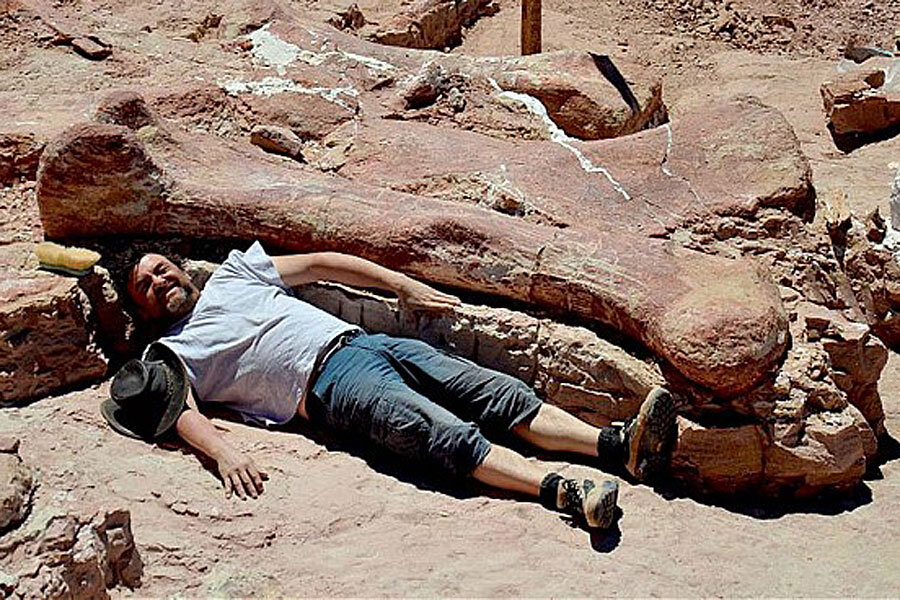New dinosaur discovery: Is this really the 'world's biggest' dinosaur?
Loading...
There's no question that this is a big dinosaur. Humongous, even.
Based on calculations taken from the size of it's femur, this critter stood seven-stories tall, was about 130-feet long, and could have weighed about 100 tonnes or about the same as 14 African elephants, according to Jose Luis Carballido, a palaeontologist at the Egidio Feruglio Museum in Trelew, Argentina.
Dr. Carballido suggests that this may be a new species of Titanosaur, a long-necked, long-tailed sauropod - a Patagonia herbivore - that walked on four legs and lived about 95 million years ago in the Cretaceous period, according to media reports and a statement posted on the museum's website.
The museum has a picture of an average-sized man stretched out next to the sauropod's femur, and he's shorter. The bones, of this as yet unnamed dinosaur, were discovered by local farmers in 2011 in the desert near La Flecha, about 135 miles west of Trelew, and were recently excavated by a team of palaeontologists from Argentina’s Museum of Palaeontology Egidio Feruglio, headed by Carballido and Diego Pol.
But is this creature really the "world's biggest" as advertised?
Dr. Paul Barrett, a dinosaur expert from London’s Natural History Museum, tells The Telegraph of London that it's premature to be talking superlatives.
Paleontologists have differing methods for calculating size and weight based on incomplete skeletons. Barrett observes that another Patagonia sauropod discovered in 1987, Argentinosaurus, was also labeled the "world's biggest." But initial estimates of its length and weight were later revised downward.
“Without knowing more about this current find it’s difficult to be sure,” Barrett told The Telegraph. “One problem with assessing the weight of both Argentinosaurus and this new discovery is that they’re both based on very fragmentary specimens – no complete skeleton is known, which means the animal’s proportions and overall shape are conjectural.”
It seems that the calculations by the palaeontologists at the Egidio Feruglio Museum will need some peer review before the "world's biggest" label can be credibly affixed to this find.
But paleontologists in Argentina weren't just talking about large dinosaurs this week.
They found also the first evidence that long-necked, whip-tailed diplodocid sauropods survived well beyond the Jurassic period. The Associated Press reported that Pablo Gallina, a researcher at Buenos Aires' Maimonides University, described the find as the first definitive evidence that diplodocids reached South America, and the most recent geologic record of this branch of sauropod anywhere.
Gallina's team says the fossils show that diplodocids roamed South America during the early Cretaceous era, well after scientists thought these kinds of dinosaurs became extinct. They also suggest that the diplodocid clade, or family group, evolved from other dinosaurs before the Earth's continents split apart, which is earlier than previously thought.
"Diplodocids were never certainly recognized from the Cretaceous or in any other southern land mass besides Africa," the authors wrote. "The new discovery represents the first record of a diplodocid for South America and the stratigraphically youngest record of this clade anywhere."
Paleobiologist Paul Upchurch at University College London, a sauropod expert who was not involved in the study, said it suggests that not all diplodocids succumbed to a mass extinction about 140 million years ago at the end of the Jurassic period.
Another expert, paleontologist John Whitlock of Mount Aloysius College in Pennsylvania, also lauded the finding.
"A discovery like this is more than just another data point. It's a chance to re-evaluate our understanding of how the group spread across the globe through time," he said.
"We can use that information to do things like examine how dinosaurs might have chased their preferred environment around the globe as the climate changed, and that's the sort of research with direct implications for those of us around today."
The research was partly funded by The Jurassic Foundation, formed by producers of the Jurassic Park films. Sebastian Apesteguia, paleontology director at Maimonides University, noted that the characters in Jurassic Park II ride a motorcycle under a diplodocid's legs.
"Until now the diplodocids were thought to be North American dinosaurs. They were the classic dinosaurs from all the Hollywood movies," he said.
Now, it seems there's evidence that the diplodocids behaved like today's North American "snowbirds."








